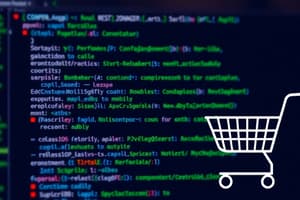Podcast
Questions and Answers
What is the purpose of specifying the correct TIn and TOut parameter and result object types when implementing a new pipe?
What is the purpose of specifying the correct TIn and TOut parameter and result object types when implementing a new pipe?
- To associate the pipe with the appropriate pipeline (correct)
- To allow the pipe to execute without any parameters
- To ensure the pipe can process any type of input
- To determine the order of execution for the pipe
What happens when the ResultCode is set to ResultCode.Error in the Execute method?
What happens when the ResultCode is set to ResultCode.Error in the Execute method?
- The pipeline exits immediately (correct)
- The pipeline continues to execute the next pipes
- An error message is logged without affecting execution
- The method returns a default value
In which project should you create a new pipe class named AddCustomerZipCode?
In which project should you create a new pipe class named AddCustomerZipCode?
- The utility functions project
- The Configured Commerce project
- The main application project
- The Extensions project (correct)
Which method serves as the entry point to a pipe and must be implemented in the new pipe class?
Which method serves as the entry point to a pipe and must be implemented in the new pipe class?
What should be done if the Customer parameter is null during the execution of the Execute method?
What should be done if the Customer parameter is null during the execution of the Execute method?
What is a necessary prerequisite for adding a new pipe to a pipeline?
What is a necessary prerequisite for adding a new pipe to a pipeline?
What does the Order property value indicate within a pipeline?
What does the Order property value indicate within a pipeline?
What is a requirement for a new pipe to replace an existing pipe?
What is a requirement for a new pipe to replace an existing pipe?
Which property of the new pipe should match the pipe being replaced?
Which property of the new pipe should match the pipe being replaced?
What does the Execute method of the FormatLabel pipe do?
What does the Execute method of the FormatLabel pipe do?
What happens to the application when the FormatLabel pipe is implemented?
What happens to the application when the FormatLabel pipe is implemented?
Which statement is true about the order value of the new pipe?
Which statement is true about the order value of the new pipe?
What is one limitation when dealing with pipes in this context?
What is one limitation when dealing with pipes in this context?
What must a pipe return from its Execute method?
What must a pipe return from its Execute method?
What is the purpose of downloading the Windows Integration Service installer?
What is the purpose of downloading the Windows Integration Service installer?
What must a pipe implement to be used within a pipeline?
What must a pipe implement to be used within a pipeline?
What is the purpose of the 'Execute' method in a pipe?
What is the purpose of the 'Execute' method in a pipe?
How are pipes within a pipeline ordered?
How are pipes within a pipeline ordered?
If a new pipe needs to be added to the second position in a pipeline, what order value should it have?
If a new pipe needs to be added to the second position in a pipeline, what order value should it have?
What would happen if a pipe returns an error code during execution?
What would happen if a pipe returns an error code during execution?
What order value do all pipelines have by default for at least one pipe?
What order value do all pipelines have by default for at least one pipe?
To add a new pipe to the start of a pipeline, what order value should it have?
To add a new pipe to the start of a pipeline, what order value should it have?
What ensures that two pipes are executed within the same pipeline?
What ensures that two pipes are executed within the same pipeline?
What action is taken if the customer parameter is null?
What action is taken if the customer parameter is null?
In which scenario would you set the ExitPipeline flag to true?
In which scenario would you set the ExitPipeline flag to true?
What is the significance of the result.SubCode property?
What is the significance of the result.SubCode property?
How is the customer postal code handled in the pipeline?
How is the customer postal code handled in the pipeline?
What will happen if the Execute method returns a result without setting any error flags?
What will happen if the Execute method returns a result without setting any error flags?
What role does the ResultMessage play in the result?
What role does the ResultMessage play in the result?
What does the Order property in the AddCustomerZipCode class indicate?
What does the Order property in the AddCustomerZipCode class indicate?
What is required to format the label successfully?
What is required to format the label successfully?
What is the primary role of handlers in Optimizely Configured Commerce?
What is the primary role of handlers in Optimizely Configured Commerce?
How are handler chains executed in Optimizely Configured Commerce?
How are handler chains executed in Optimizely Configured Commerce?
What functionality does the GetCartHandler chain provide?
What functionality does the GetCartHandler chain provide?
In what way are pipelines similar to handler chains?
In what way are pipelines similar to handler chains?
What is a distinguishing feature of pipelines compared to earlier versions of Configured Commerce?
What is a distinguishing feature of pipelines compared to earlier versions of Configured Commerce?
When is the GetProductHandler chain executed?
When is the GetProductHandler chain executed?
What is the 'CreateProductDtos' catalog pipeline responsible for?
What is the 'CreateProductDtos' catalog pipeline responsible for?
Which statement correctly describes how pipelines interact with handler chains?
Which statement correctly describes how pipelines interact with handler chains?
Flashcards
Handlers
Handlers
Objects that process business logic in Configured Commerce after a REST API request.
Handler Chains
Handler Chains
Organized sets of handlers executed sequentially.
GetCartHandler
GetCartHandler
A handler chain retrieving cart data for an authenticated user or by ID.
GetProductHandler
GetProductHandler
Signup and view all the flashcards
Pipelines
Pipelines
Signup and view all the flashcards
Pipes
Pipes
Signup and view all the flashcards
IPipe interface
IPipe interface
Signup and view all the flashcards
Execute method
Execute method
Signup and view all the flashcards
Order property
Order property
Signup and view all the flashcards
Pipeline Order
Pipeline Order
Signup and view all the flashcards
Pipe Order Increments
Pipe Order Increments
Signup and view all the flashcards
Inserting Pipes
Inserting Pipes
Signup and view all the flashcards
Replacing pipes
Replacing pipes
Signup and view all the flashcards
WindowsIntegrationService
WindowsIntegrationService
Signup and view all the flashcards
Cart Data
Cart Data
Signup and view all the flashcards
Product Identifier
Product Identifier
Signup and view all the flashcards
Product Detail Page
Product Detail Page
Signup and view all the flashcards
Quick Order Page
Quick Order Page
Signup and view all the flashcards
Checkout Address
Checkout Address
Signup and view all the flashcards
Review and Pay Page
Review and Pay Page
Signup and view all the flashcards
Cart Lines
Cart Lines
Signup and view all the flashcards
Shipping Costs
Shipping Costs
Signup and view all the flashcards
Taxes
Taxes
Signup and view all the flashcards
Available Carriers
Available Carriers
Signup and view all the flashcards
Non-transactional Logic
Non-transactional Logic
Signup and view all the flashcards
Study Notes
Handlers
- Handlers are objects responsible for processing business logic in Configured Commerce.
- Handlers execute after the REST API receives and processes a request.
- Handlers are organized into chains that operate on specific objects.
- Each handler in a chain is executed in a configured order until there are no more handlers.
- The
GetCartHandlerchain retrieves and returns the cart object for the authenticated user or using a cart identifier. - The
GetCartHandlerchain includes handlers for retrieving cart-related data such as cart lines, shipping costs, taxes, and available carriers. - The
GetCartHandlerchain is used indirectly throughout the storefront, including when a user visits the Cart page, navigates to the Checkout Address page, and proceeds to the Review and Pay page. - The
GetProductHandlerchain retrieves a product given a product identifier. - The
GetProductHandlerchain is executed when a user visits the Product Detail page or searches for a product on the Quick Order page. - New handlers can be added to existing handler chains to insert new business logic.
Pipelines
- Pipelines are reusable portions of business logic that are not transactional.
- Pipelines are made up of one or more classes, called pipes.
- Pipelines are similar to handler chains.
- Pipelines can be executed wherever the logic is needed.
- Individual pipes within a pipeline can halt execution of the rest of the pipeline by returning an error code or exiting the pipeline.
- To be used within a pipeline, a pipe must:
- Implement the
IPipeinterface. - Return a result from the
Executemethod. - Specify an order via the
Orderproperty.
- Implement the
- The
Executemethod is the sole entry point into a pipe and contains the business logic used by the pipe. - The
Orderproperty is used to specify the order of the pipe within the pipeline. - Pipes within a pipeline are executed in ascending order based on the
Orderproperty. - Pipelines have at least one pipe with an order value of 100.
- Additional pipes typically increment the order by 100.
- A new pipe can be added to a pipeline by specifying an order value within a specific range.
- To insert a new pipe in between existing pipes, the order value should be between the order values of the existing pipes.
- To add a new pipe to the start or end of a pipeline, the pipe should be given an order value less than 100 or greater than the highest order value in the pipeline, respectively.
- It is possible to replace an existing pipe in a pipeline.
- To replace an existing pipe, the new pipe must:
- Implement the
IPipeinterface. - Return a result from the
Executemethod. - Specify an order via the
Orderproperty. - Be named the same as the pipe being replaced.
- The
Ordervalue for the new pipe should match theOrdervalue of the pipe being replaced.
- Implement the
- You cannot "remove" a pipe, but you can create an implementation of it that does nothing.
Windows Integration Service
- Download the Windows Integration Service installer for Configured Commerce if the
WindowsIntegrationServicefolder is not present in your local copy of Configured Commerce. - Unzip the
WindowsIntegrationServicefolder into your Configured Commerce project folder and follow the installation instructions.
Studying That Suits You
Use AI to generate personalized quizzes and flashcards to suit your learning preferences.
Description
Explore the role of handlers in Configured Commerce, including their function and execution within the REST API framework. This quiz covers the processes involved in cart and product retrieval and highlights the importance of handler chains in the e-commerce experience.



